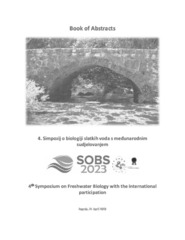Приказ основних података о документу
Assessment of ecological potential of the Medjuvršje reservoir based on benthic macroinvertebrates
| dc.contributor | Mičetić Stanković, Vlatka | |
| dc.contributor | Ivković, Marija | |
| dc.contributor | Matoničkin Kepčija, Renata | |
| dc.contributor | Sertić Perić, Mirela | |
| dc.contributor | Miliša, Marko | |
| dc.contributor | Vilenica, Marina | |
| dc.creator | Đikanović, Vesna | |
| dc.creator | Skorić, Stefan | |
| dc.creator | Tubić, Bojana | |
| dc.creator | Jovičić, Katarina | |
| dc.date.accessioned | 2023-05-26T10:14:19Z | |
| dc.date.available | 2023-05-26T10:14:19Z | |
| dc.date.issued | 2023 | |
| dc.identifier.issn | 2459-8402 | |
| dc.identifier.uri | http://radar.ibiss.bg.ac.rs/handle/123456789/5701 | |
| dc.description.abstract | The Medjuvršje reservoir is a highly modified water body on the Zapadna Morava River by the construction of a hydroelectric power plant. According to the national regulation it belongs to type 2 watercourses, i.e. large rivers with mineral substrates of medium grain size. The aim of this study was to evaluate the potential of the Medjuvršje reservoir using bioindicative properties of benthic macroinvertebrates, taking into consideration their community composition. Macrozoobenthos were collected from two sites in the littoral zone of the reservoir using a standard hand net following the standard methodology (EN 27828). Specimens were sorted and identified under a stereo microscope using the appropriate identification keys. Assessment of the reservoir’s ecological potential was carried out based on the class boundaries for Type 2 rivers using several biotic parameters calculated from AQEM (2002). The representatives of Oligochaeta, Mollusca, Odonata and Chironomidae were most abundant in the benthic community. The larval stages of the insects Ephemeroptera, Heteroptera, Coleoptera and Trichoptera were recorded only from the microhabitats with abundant macrophyte vegetation. Within this study, we also recorded the first finding of a freshwater sponge for this type of water body. Based on the macrozoobenthos composition and according to analyzed indices (saprobic index Zelinka & Marvan, BMWP and ASPT score, Diversity index Shannon-Weaner, Total number of taxa, share of Oligochaeta-Tubificidae) the ecological potential was assessed as good (II class of Water quality). However, when the EPT index was considered, the status deteriorated to IV (site 1) or V class (site 2) as poor or bad status. | sr |
| dc.language.iso | en | sr |
| dc.publisher | Zagreb: Croatian Association of Freshwater Ecologists | sr |
| dc.relation | info:eu-repo/grantAgreement/MESTD/inst-2020/200007/RS// | sr |
| dc.rights | openAccess | sr |
| dc.source | Book of Abstracts: 4th Symposium on Freshwater Biology with the international participation; 2023 Apr 21; Zagreb, Croatia | sr |
| dc.subject | benthic macroinvertebrates | sr |
| dc.subject | the Medjuvršje reservoir | sr |
| dc.subject | ecological potential assessment | sr |
| dc.title | Assessment of ecological potential of the Medjuvršje reservoir based on benthic macroinvertebrates | sr |
| dc.type | conferenceObject | sr |
| dc.rights.license | ARR | sr |
| dc.rights.holder | © 2023 by the Croatian Association of Freshwater Ecologists | sr |
| dc.description.other | Mičetić Stanković V, Ivković M, Matoničkin Kepčija R, Sertić Perić M, Miliša M, Vilenica M, editors. Book of Abstracts: 4th Symposium on Freshwater Biology with the international participation; 2023 Apr 21; Zagreb, Croatia. Zagreb: Croatian Association of Freshwater Ecologists; 2023. p. 39. | sr |
| dc.citation.spage | 39 | |
| dc.type.version | publishedVersion | sr |
| dc.identifier.fulltext | https://radar.ibiss.bg.ac.rs/bitstream/id/12947/bitstream_12947.pdf | |
| dc.citation.rank | M34 | |
| dc.identifier.rcub | https://hdl.handle.net/21.15107/rcub_ibiss_5701 |

